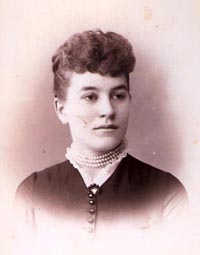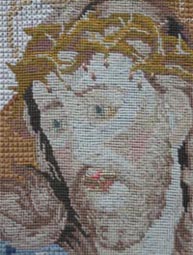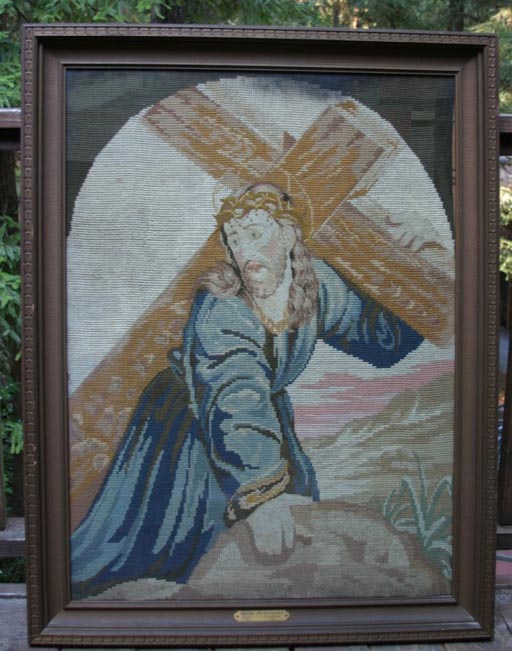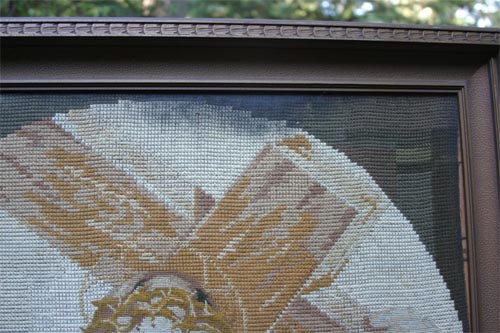Verna Brady's
Grandmother's Needlepoint
 |
 |
One of the biggest influences in Verna's childhood was the needlepoint made by her Grandmother Agatha (Aggie) Hirschauer while she was a student in a convent school in Hamilton, Ohio. This needlepoint took 11 years to complete (1882-1893) and was displayed on the living room wall as Verna was growing up. She always felt it was a major influence in her dream of becoming an artist. It is an exquisite piece of needlepoint, especially done by a school-age child, and gave Verna the confidence that she too could do something as ambitious as this needlepoint.

The needlepoint was in a house fire at in Evansville, Indiana, where the Henns were living during that period, somewhere around 1924-25. You can see in the upper right center some of the damage from the fire. The story goes that the wall (and house) all around it burned down, but the needlepoint was preserved, except for this small amount of damage, and some damage to the original frame. The needlepoint was removed from the original white frame for transporting when they moved out to the east coast. Then it was reframed with the darker frame which is therefore a later vintage that the original needlepoint.

Fire damage
For more about this needlepoint, see this essay written by Verna's niece Deborah Henn.
My family's only heirloom is a valuable piece of art, which was made by my great maternal grandmother, Agatha Hirshauer Henn, between the years 1882 and 1893. This heirloom is a religious picture depicting Christ's first fall carrying the Cross up to Mount Calvery. The picture, which measures twenty-nine inches by thirty-three inches, is a duplicate of a very small holy card.
One of the amazing characteristics of my great grandmother's picture is that it is believed to be completely reversed from the picture copied off the holy card. The reason for this is that my great grandmother was possibly one of the few people, like DaVinci, who saw everything backward, as if she were looking in a mirror.
The materials and the method my great grandmother used to make her entire picture were wool yarn embroidered in cross-stitch and petit point stiches on burlap. The construction of this type of picture is know as Berlin woolwork, which was one of the most characteristic styles of embroidery in the United States during the 19th century.
Over the eleven years that it took my grandmother to complete this picture, she did an excellent job of matching the different colors of wool she used. The shading and detail she achieved in this picture using wool yarn and a needle are astonishing. The images of Christ and the Cross seem to be almost three dimensional. The expression on the face of Christ distinctly shows suffering and agony. The rugh surfaces of the cross, made from the hand tools by which wood was cut in those days, are clearly visible in the picture. She used dark, dull, and natural colors throughout the picture to symbolize agony and sorrow.
The entire visual affect of the composition of this picture is sorrowful, solemn, and sobering. And yet, at the same time, it is also very quieting and comforting.
Deboral A. Henn
April 1975